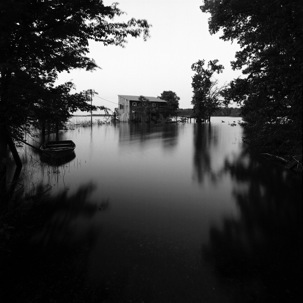









Floodwaters from the record flood, spring 2011, surround a duck hunting club near Olive Branch, Illinois.
Collected written works | Gary Marx

Introduction
It takes only a glance at a map to see that Alexander County is not one of those counties defined by straight lines and right angles. This is a county whose boundaries are, for the most part, waterways. Only the northern boundary, which separates it from the rest of the state, is laid out along an easy east-west latitude.
From the air, you can make out the county’s serpentine outlines — the deep green woods that snake along Mill Creek and the Cache River, and the gray-blues and browns of the Mississippi and Ohio. You can see, too, what lies within those boundaries — the etched and shadowed greens that are the wooded hills and ravines of the Shawnee National Forest. Just south of this lies the blue hook of Horseshoe Lake. And around the edges of the county — running all the way out to the rivers — are vast, flat farm fields that butt to the base of the levees. There are towns, too, and the city of Cairo.
This view from the air shows all of that, but the most dominant geographic feature, the one that most defines Alexander County, is the merging of the two great rivers. The Miss and the Ohio are North America’s largest waterways, and there is no place like this on the continent, perhaps the world.
If you look closely at the place where these rivers merge, you’ll see that the waters do not easily come together. The swift, muddy browns from the north and the slower blues from the east collide and churn, wrestling for dominance. And for a mile or more downstream, you can still make out their distinct character. The river retains the name of one, but it has been changed inexorably by the other. The Mississippi and the Ohio are neither; they have become a third thing.
Great power and potential lie here at the confluence, but it is a power only partially tapped and a potential largely unfulfilled. This region has not reaped great rewards from its geographic location, and it has been more servant than master of its own fate. Except for brief periods in its history, when railroads and bridges fueled speculation and spurts of growth, it has never fully prospered. Instead, it became a stepping off place for travelers, a bivouac for soldiers and a place where impatient investors rolled dice and lost. In many respects, Alexander County has been a transfer station for an economy bound for elsewhere.
There are many reasons why that is, and you won’t easily find two people here who agree. But such is the nature of opinion in a region where independence and self-reliance are two of the highest virtues.
As with other geographic regions, the environment influences the character of the people who live there. Without resorting to generalities or painting with a brush too broad, it might be argued that Alexander County’s rough-hewn nature and its geopolitical isolation have bred a form of community-based individualism. While there may be a strong desire to do-it-yourself and go-it-alone, there is also a palpable willingness to help others. You can sense this on the streets of Cairo sometimes, in the gatherings of volunteer groups, and in churches, cafes and taverns. And you see it most apparent during times of crisis.
There may be a lot of people living below the poverty line in this southernmost county of Illinois, but there’s an incalculable richness to a quality of life that others may not immediately recognize. With jobs and careers scarce, people know they have to be good at a number of things in order to survive. So you’ll find all manner of rustic renaissance men and women. They work day jobs and farm on the weekends. They hunt and garden. There are those who repair motors and engines in the afternoon and tend bar in the evening. They run small businesses out of their kitchens and garages. There are musicians and teachers who will sling hammers on construction sites, and there are people who get by on sheer pride and pluck.
These are river folk and farmers, preservationists and demolition proponents, blacks and whites, tree huggers and timber men, the religious and the not so much. When they come together — like the two great rivers — they don’t always mix easily, yet something else emerges: a third thing. There are many currents here — economic, sociological, historical and natural — and there are more than rivers that converge at the confluence.
Here, too, there are photographs and words.
— 30 —
